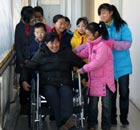-
-
China Daily E-paper
Web Comments
What is behind the labor shortage?
By Gao Qihui (chinadaily.com.cn)
Updated: 2010-02-25 17:22
 |
Large Medium Small |
The Chinese Spring Festival has just ended, but anxiety about a shortage of of workers is expanding into many low-end, labor-intensive enterprises in the Yangtze and Pearl River deltas. The gap amounts to more than two million, according to the Beijing Morning Post.
What an optimistic sign for China. While the US and other countries struggle to reduce unemployment, has China created surplus job opportunities?
Actually, it should be called the peasant-workers shortage, and it is concentrated in labor-intensive industry that provides low-paying, physically demanding work. Some enterprises defend themselves by claiming that new-generation workers cannot bear the hardship of tough basic jobs like construction any more. Let us dig out what the real situation is in these factories.
In those enterprises, the working environment is always harmful to health, the basic welfare of workers can not be ensured and the legal rights of employees are overridden by ruthless employers. Their overbearing tactics include failing to pay workers, prolonging work hours without extra pay, refusing compensation for production accidents and arbitrarily laying off workers when orders fall. Maybe they are what we call "sweatshops".
However, as the Chinese government emphasizes the rights of civilians, more and more workers become conscious of their legal rights. The once "silent and tame" workers start to claim their rights and do not want to compromise for poor treatment any more.
Meanwhile, these migrant-workers have another alternative. The inland provinces developed so fast in past years that many job opportunities have been created there. Many workers choose jobs in these places because salaries are in some cases almost on par with coastal areas and it's simply closer to home.
Moreover, the new generation of workers, especially peasant-workers, are more educated and ambitious than their parents, so that they have a higher expectation of jobs. The simple and repetitive work in traditional low-end, labor-intensive enterprises cannot match their expectations.
As one generation of workers is retiring and the one-child policy's outcomes begin to take effect, China's labor market is turning from excessive supply to labor shortages.
The trend is irreversible due to modernization and industrialization. Consequently, low-end, labor-intensive processing enterprises need rethink their old strategy of squeezing profit from hard-working laborers through poor treatment and unfair practices. They should seek profit from higher quality and added value of products. The solution is to upgrade their technology to increase profitability and reduce dependence on manpower.
For those which are not capable or willing to change, we can see their fated elimination in the near future and they do not deserve any sympathy. In the upgrading process of China's industrial structure, the situation is a case of survival of the fittest.









